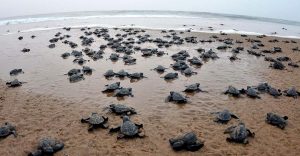Gender ratio of turtle hatchlings in Odisha tilts heavily toward females: Study

Kendrapara: The sex ratio of newborn turtles at the Rushikulya nesting site in Odisha’s Ganjam district tilts towards females, according to a research work on Olive Ridley sea turtles.
The research work titled ‘Monitoring Sea Turtles in India 2008- 2024’ was a joint endeavour of the Indian Institute of Science (IIS), Bengaluru and Dakshin Foundation, Bengaluru.
The research paper recently published throws light on such biological attributes and gender ratio of turtles sighted on the Odisha coast, said B C Chaudhury, turtle biologist and former scientist of Wildlife Institute of India (WII), Dehradun.
The newborn gender ratio at the Rushikulya nesting site was found to be heavily tilting towards females at 71 per cent. The research is, however, yet to cover the turtles at the Gahirmatha nesting site, widely regarded as the world’s largest rookery of Olive Ridley sea turtles.
The study on the migratory behavioural instinct of sea turtles along the Odisha coast has found that these delicate marine animals, which are conferred endangered status because of dwindling population worldwide, do not travel as far off as it was being speculated.
While some of the turtles remain in the offshore sea waters of Odisha, others migrate to Sri Lanka and the Gulf of Mannar as per the post-nesting migration study of Olive Ridley sea turtles in India initiated by WII and Odisha Forest department, Chaudhury stated.
The mass-nesting of Olive Ridley sea turtles, otherwise called arribada, is an annual ritual that takes place at Gahirmatha, Rushikulya and Devi river mouth beaches in Odisha.
Unlike humans, sea turtles do not have sex chromosomes. Their sex is determined by the temperature of the sand where their eggs incubate, a phenomenon called temperature-dependent sex determination (TSD).
Being polygamous male sea turtles can mate with a maximum of two to three female turtles for which falling numbers of male turtles will be a disaster for the turtle population, he said.
An Olive Ridley usually lays about 120 to 150 eggs, from which hatchlings emerge after about 45 to 50 days. But not all eggs remain intact as predators devour them. Besides, eggs are also washed away by sea waves during high tide. The eggs are incubated in the nest and grow, sans mother, to emerge as hatchlings.
This year, more than six lakh turtles had invaded the beach at Gahirmatha to lay eggs while the rookery at Rushikulya in Odisha played host to seven lakh turtles for en-masse nesting.
PTI
News